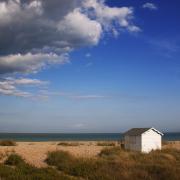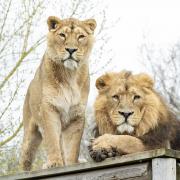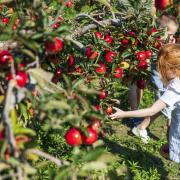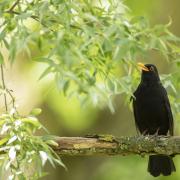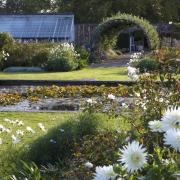Red squirrels need all the help they can get to survive and thrive – Anna finds out what’s going on here to ensure that happens, from keeping their pushy grey cousins at bay, to breeding the next generation
Did you know there's a Squirrel Appreciation Day? If you've ever lost spring bulbs to squirrels or seen the damage they can do in stripping bark from woodland trees, you might find them hard to appreciate, but it's almost certainly grey squirrels that have caused the problem, due to the scarcity of Britain's only native squirrel: the red. 'Until the 1800s it was the red squirrel, Sciurus vulgaris, that would have been commonly seen scurrying around the UK countryside, identified through its distinctive orange-red fur and tufty ears and a large bushy tail that almost matches the size of its body,' explains Sally Smith of Kent Wildlife Trust.

Feeding on seeds and nuts - with nuts from pine trees a favourite - the species also tucks into fruit, tree shoots, even fungi. They have a life span of around six years, though have been known to live for up to ten in protected enclosures. ‘Red squirrels have evolved naturally with our native woodlands and have unique behaviours that benefit the ecosystem. They store seeds by burying them and, in time, some of them will germinate into new trees. The reds also spread mycorrhizal fungi spores, which is important for healthy trees. While some of these positive behaviours are replicated by the grey, the damage they case is greater, not only because they are larger but down to the fact they ring-bark [or 'gnaw', and thus damage], trees more than reds do. What's more reds don't eat woodland bird eggs or chicks and greys do, which further damages our native woodlands.’
Once, reds were such a common sight in our countryside that the species inspired The Tale of Squirrel Nutkin a book written and illustrated by renowned children’s author Beatrix Potter, whereby a plucky red squirrel named Nutkin escapes a near-fatal encounter with an owl called Old Brown, losing his bushy red tail. So when and why did their numbers begin to fall?

‘The grey squirrel was introduced to the UK from North America back in the late 1800s as a then-novelty creature brought in to adorn the grounds of England stately homes – that’s really when the problems began,’ explains Sally. ‘The non-native grey [Sciurus carolinensis] outsized the reds and out-competed them for both food and habitat. Perhaps more significant, though, was the “squirrel-pox” carried by the grey - they were immune to it, but it proved deadly for the reds.'
Disease coupled with habitat loss saw the number of red squirrels fall dramatically and today, according to charity the Red Squirrel Survival Trust [RSST], there are thought to be around 287,000 of the native red species in the UK, compared to around 2.7m of their larger, North American cousins.
How can we redress the balance? 'Conservation efforts to help red squirrels thrive continue and, while low in number, there are populations in Scotland, small parts of northern England and Wales, and some coastal islands, like Brownsea Island in Dorset. There are also declining populations in Ireland,' explains Sally.
‘We know that, without urgent action, we risk losing this native species from our landscape altogether, so charities and organisations like ours are doing all we can as far as their conservation is concerned. A number of county-based Wildlife Trusts - though not currently ours here in Kent - now form part of the Red Squirrel Recovery Network, which is made up of over 50 groups committed to bringing red squirrels back from the brink of extinction.'

Though we can’t yet find red squirrels in the wild here in Kent, the team at the Wildwood Trust has been breeding red squirrels for reintroduction into suitable habitat in North Wales and Anglesey for over 20 years. Regular visitors to its Kent-based park near Herne Bay will have spotted new enclosures for the charismatic creatures, built last year as a home for the Trust's resident reds. Says Animal Registrar Judi Dunn, who's been working with the red squirrels since their introduction to the park, 'Our breeding pair, Rose and Nutkin, have proved excellent parents and their young from previous years have helped contribute to the recovery of this incredible species across the country. We had an exceptionally good breeding year in 2023. Rose is an amazing mother, giving birth to three separate litters over the course of last year’s breeding season. In the wild, squirrels often only have one litter, or if there are good feeding conditions they may produce two litters, but three is very rare. Last year, Rose produced a total of eight babies - or kits as baby squirrels are known.’
Judi says the keepers couldn't believe their eyes when they went to check the group last autumn. 'It is normally a process of counting six red squirrels: Mum, Dad, and four juveniles,” 'Last year, though, there was a tiny seventh baby in the group, and then the excitement kept coming when the next day, eight squirrels were spotted running around the enclosure.'
Of the eight kits, Wildwood in Kent have kept three, with five going to other independent red squirrel collections, all members of the collective national captive breeding group, from Yorkshire Arboretum to The Newt country estate in Somerset, helping to keep the species increasing in number across the country.

Meanwhile, plans are afoot to help control numbers of grey squirrels, the results of which no doubt KWT and Wildwood will be watching with interest. The first year of the project, which was announced last autumn, will involve collecting baseline data on squirrel populations and building on emerging science to support the delivery of grey-squirrel fertility control - yes, contraceptives for grey squirrels are on the way.
With the government's Department for Environment, Food & Rural Affairs [DEFRA] currently leading the research, RSST reports that, '.... developing an oral contraceptive for the grey squirrel is at an advanced stage. Hand in hand with the development of the chemistry is the design of a species-specific distribution hopper, inaccessible to red squirrels and other animals and birds, so the contraceptive effect is strictly controlled...The addition of a contraceptive for grey squirrels to other control measures will lead rapidly to a natural drop in their numbers, allowing the population of red squirrels to recover gradually and naturally until they once again flourish throughout the United Kingdom. In turn, native broadleaf trees will gain respite from the bark stripping by grey squirrels that leaves them vulnerable to disease and pathogens.'

Back here in the county, Wildwood Trust is working with KWT, Ashdown Forest and Forestry England to assess the feasibility of restoring pine martens (Martes martes) to the south east of England in another project that's still in its early stages. Explains Sally Smith, ‘Pine martens are omnivorous mammals, members of the mustelid family that also includes otters and badgers, and they play important ecological roles that contribute to a biodiverse environment by dispersing the seeds of the fruits they eat, as well as influencing small mammal populations by preying on them as part of their varied diet. Evidence from Ireland and Scotland suggests that, where there are high numbers of pine martens, grey squirrel numbers are lower or decreasing, while red squirrel numbers are increasing within as little as 15 years of pine martens recolonising an area. There is evidence from diet analysis that pine martens do eat grey squirrels. They'll occasionally prey on red squirrels, too, but red squirrels are small and agile and harder to catch than their larger, slower, more abundant grey relatives. Grey squirrels also spend more time on the ground, so are likely to be easier prey for pine martens.'
Clearly there’s plenty going on to control numbers of greys, then, and encourage numbers of reds to rise. So will there be more red-squirrel breeding at Wildwood this year? 'Rose has done such a brilliant job this year, we felt it was time to give her a rest,' says Judi, 'The boys are all in one area, the girls in another enclosure, and they’re all relaxing for a bit. They're all still around to view, though, and, as ever, we're encouraging visitors. And later in the year, we will matching up new breeding pairs for 2025.’
So if you want to see Kent's red squirrels at their liveliest and possibly most laid-back, away as they currently are from the pressures of mating and parenthood, head to Wildwood, Kent.
kent.wildwoodtrust.org; kentwildlifetrust.org.uk

















